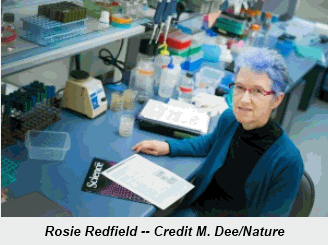|
|
|
|
|
|
|
News & Views item - January 2012 |
![]() Can Arsenic Substitute for Phosphorus in DNA, RNA and Protein? (January 23,
2012)
Can Arsenic Substitute for Phosphorus in DNA, RNA and Protein? (January 23,
2012)
In December last year Felisa Wolfe-Simon1 and her colleagues announced that:
Life is mostly composed of the elements carbon, hydrogen, nitrogen, oxygen, sulfur, and phosphorus,... [but] it is theoretically possible that some other elements in the periodic table could serve the same functions. Here, we describe a bacterium, strain GFAJ-1 of the Halomonadaceae, isolated from Mono Lake, California... Our data show evidence for arsenate in macromolecules that normally contain phosphate, most notably nucleic acids and proteins.
 The
suggestion was met with considerable scepticism2 and Rosie Redfield
at the University of British Columbia in particular has spent much of the last
year developing evidence against the claim3.
The
suggestion was met with considerable scepticism2 and Rosie Redfield
at the University of British Columbia in particular has spent much of the last
year developing evidence against the claim3.
Now Nature's Erika Check Hayden has reported on the latest instalment of the controversy. Professor Redfield and her group have posted data on her blog that they claim present a “clear refutation” of Wolfe-Simon's key findings. Professor Redfield writes: "Their most striking claim was that arsenic had been incorporated into the backbone of DNA, and what we can say is that there is no arsenic in the DNA at all."
In response Dr Wolfe-Simon emailed to Nature: "We are thrilled that our results are stimulating more experiments from the community as well as ourselves. We do not fully understand the key details of the website experiments and conditions. So we hope to see this work published in a peer-reviewed journal, as this is how science best proceeds."
Professor Redfield's evidence:
GFAJ-1 would not grow unless at least some phosphorus was present in the culture medium.
DNA purified from such cultures when subjected to equilibrium density-gradient centrifugation in CsCl and analysed by mass spectrometry showed no trace of arsenic.
So was the concentration of phosphorus in the medium too high? Was the arsenic bond so fragile that CsCl made the DNA disintegrate? Professor Redfield replies that all of the DNA purified on the gradient was analysed, so any arsenic present would have been detected. In addition Nature reports: "Redfield also analysed the size of DNA from cells that had been stored for two months in her lab refrigerator. The DNA fragments from cells that had been grown with and without arsenic were similar sizes, indicating that DNA from arsenic-grown cells is not unstable.
While it may be a long while yet before Wolfe-Simons is prepared to retract her claims Ronald Oremland at the US Geological Survey in Menlo Park, California, who led the arsenic-life work1, told Nature that the results "do not look encouraging for the arsenic-in-DNA hypothesis", nevertheless he will issue an official comment only once peer reviewers have examined Professor Redfield's data.
As far as Professor Redfield is concerned Nature writes: "Redfield, however, does not plan to do additional experiments to address objections raised by defenders of the arsenic-life hypothesis. 'We've done our part. This is a clean demonstration, and I see no point in spending any more time on this,' she says."
____________________________________________
1Wolfe-Simon, F. et al. Science doi:10.1126/science.1197258 (2010).
2 http://www.nature.com/news/2010/101202/full/news.2010.645.html#comments
3 http://rrresearch.fieldofscience.com/#uds-search-results and type arsenic in the search box.